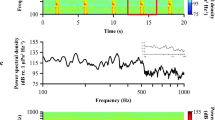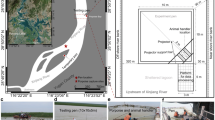Abstract
Invasive silver (Hypophthalmichthys molitrix) and bighead (H. nobilis) carp, collectively referred to as bigheaded carps, threaten aquatic ecosystems of the Upper Midwestern USA. Due to the extensive ecological impacts associated with these species, prevention of their further range expansion is the aim for fisheries management. Recent behavioral studies indicate bigheaded carps are deterred by acoustic barriers and exhibit negative phonotaxis in response to anthropogenic sound sources (≥ 150 dB re 1 μPa). However, the impact of long-term exposure to these sounds on the hearing capabilities of bigheaded carps has not been well documented. In this study, the auditory evoked potential (AEP) technique was used to determine auditory thresholds among bigheaded carps before and after exposure to high intensity (155.7 ± 4.7 dB re 1 μPa SPLrms; − 8.0 ± 4.7 dB re 1 ms−2 PALrms; mean ± SD) broadband sound. Fish were exposed to sound for 30 min or 24 h and AEP measurements were taken at three time points: immediately after exposure, 48 h, or 96 h later. Results indicate that silver and bighead carp experience temporary threshold shifts (TTSs) in frequency detection following sound exposure with the magnitude and length of TTS correlated with exposure duration. The findings from this study will be used to increase the long-term efficacy of acoustical deterrent measures aimed at preventing further range expansion of bigheaded carps.





Similar content being viewed by others
References
Amoser S, Ladich F (2003) Diversity in noise-induced temporary hearing loss in otophysine fishes. J Acoust Soc Am 113(4):2170–2179. https://doi.org/10.1121/1.1557212
Anderson KR, Chapman DC, Wynne TT, Masagounder K, Paukert CP (2015) Suitability of Lake Erie for bigheaded carps based on bioenergetic models and remote sensing. J Great Lakes Res 41(2):358–366. https://doi.org/10.1016/j.jglr.2015.03.029
Bhandiwad AA, Whitchurch EA, Colleye O, Zeddies DG, Sisneros JA (2017) Seasonal plasticity of auditory saccular sensitivity in ‘sneaker’ type II male plainfin midshipman fish, Porichthys Notatus. J Comp Physiol A 203:211–222. https://doi.org/10.1007/s00359-017-1157-9
Cooke SL, Hill WR (2010) Can filter-feeding asian carp invade the Laurentian great lakes? A bioenergetic modelling exercise. Freshw Biol 55(10):2138–2152. https://doi.org/10.1111/j.1365-2427.2010.02474.x
Corwin JT, Bullock TH, Schweitzer J (1982) The auditory brain stem response in five vertebrate classes. Electroencephalogr Clin Neurophysiol 54:629–641. https://doi.org/10.1016/0013-4694(82)90117-1
Cuddington K, Currie WJS, Koops MA (2014) Could an Asian carp population establish in the Great Lakes from a small introduction? Biol Invasions 16(4):903–917. https://doi.org/10.1007/s10530-013-0547-3
Egner SA, Mann DA (2005) Auditory Sensitivity of Sergeant Major Damselfish Abudefduf Saxtilis from Post-Settlement Juvenile to Adult. Mar Ecol Prog Ser 285:213–222. https://doi.org/10.3354/meps285213
Fay RR (1974) Sound reception and processing in the carp: saccular potentials. Comp Biochem Physiol A 49(1):29–42. https://doi.org/10.1016/0300-9629(74)90539-8
Higgs DM, Souza MJ, Wilkins HR, Presson JC, Popper AN (2001) Age-and Size-Related Changes in the Inner Ear and Hearing Ability of the Adult Zebrafish (Danio Rerio). JARO 03:174–84. https://doi.org/10.1007/s101620020035
Irons KS, Sass GG, McClelland MA, Stafford JD (2007) Reduced condition factor of two native fish species coincident with invasion of non-native Asian carps in the Illinois River, USA. Is this evidence for competition and reduced fitness? J Fish Biol 71:258–273. https://doi.org/10.1111/j.1095-8649.2007.01670.x
Jewett DL, Williston JS (1971) Auditory evoked far-fields averaged from the scalp of humans. Brain. 94:681–696. https://doi.org/10.1093/brain/94.4.681
Jewett DL (1970) Volume-conducted potentials in response to auditory stimuli as detected by averaging in the cat. Electroencephalogr Clin Neurophysiol 28:609–618. https://doi.org/10.1016/0013-4694(70)90203-8
Kojima T, Ito H, Komada T, Taniuchi T, Akamatsu T (2005) Measurements of auditory sensitivity in common carp Cyprinus Carpio by the auditory brainstem response. Fish Sci 71:95–100. https://doi.org/10.1111/j.1444-2906.2005.00935.x
Kolar CS, Chapman D C, Courtenay WR Jr., Housel CM, Williams JD, and Jennings DP. 2007. Bigheaded carps : a biological synopsis and environmental risk assessment. American Fisheries Society. Special Publication 33:204
Ladich F, Fay RR (2013) Auditory evoked potential audiometry in fish. Rev Fish Biol Fish 23:317–364. https://doi.org/10.1007/s11160-012-9297-z
Mann DA, Higgs DM, Tavolga WN, Souza MJ, Popper AN (2001) Ultrasound Detection by Clupeiform Fishes. J Acoust Soc Amm 109:3048–3054. https://doi.org/10.1121/1.1368406
Maruska KP, Boyle KS, Dewan LR, Tricas TC (2007) Sound production and spectral hearing sensitivity in the Hawaiian sergeant damselfish, Abudefduf Abdominalis. J Exp Biol 210:3990–4004. https://doi.org/10.1242/jeb.004390
Murchy KA, Cupp AR, Amberg JJ, Vetter BJ, Fredricks KT, Gaikowski MP, Mensinger AF (2017) Potential implications of acoustic stimuli as a non-physical barrier to silver carp and bighead carp. Fish Manag Ecol 24(3):208–216. https://doi.org/10.1111/fme.12220
Popper AN, Fay RR (2011) Rethinking sound detection by fishes. Hear Res 273:25–36. https://doi.org/10.1016/j.heares.2009.12.023
Radford CA, Montgomery JC, Caiger P, Higgs DM (2012) Pressure and particle motion detection thresholds in fish: a re-examination of salient auditory cues in Teleosts. J Exp Biol 215:3429–3435. https://doi.org/10.1242/jeb.073320
Sampson SJ, Chick JH, Pegg MA (2009) Diet overlap among two Asian carp and three native fishes in Backwater Lakes on the Illinois and Mississippi Rivers. Biol Invasions 11(3):483–496. https://doi.org/10.1007/s10530-008-9265-7
Sass GG, Cook TR, Irons KS, McClelland MA, Michaels NN, Matthew O’Hara T, Stroub MR (2010) A mark-recapture population estimate for invasive silver carp (Hypophthalmichthys Molitrix) in the La Grange Reach, Illinois River. Biol Invasions 12(3):433–436. https://doi.org/10.1007/s10530-009-9462-z
Sass GG, Collin Hinz AC, Erickson NN, McClelland MA, Mc Clelland MA, Epifanio JM (2014) Invasive bighead and silver carp effects on zooplankton communities in the Illinois river, Illinois, USA. J Great Lakes Res 40(4):911–921. https://doi.org/10.1016/J.JGLR.2014.08.010
Scholik AR, Yan HY (2002) Effects of boat engine noise on the auditory sensitivity of the fathead minnow, Pimephales promelas. Environ Biol Fish 63(2):203–209. https://doi.org/10.1023/A:1014266531390
Scholik AR, Yan HY (2001) Effects of underwater noise on auditory sensitivity of a cyprinid fish. Hear Res 152(1–2):17–24. https://doi.org/10.1016/S0378-5955(00)00213-6
Schrank SJ, Guy CS, Fairchild JF (2003) Competitive interactions between age-0 bighead carp and paddlefish. Trans Am Fish Soc 132(6):1222–1228. https://doi.org/10.1577/T02-071
Sisneros JA, Popper AN, Hawkins AD, Fay RR (2016) Auditory evoked potential audiograms compared with behavioral audiograms in aquatic animals. In: Popper AN, Hawkins A (eds) The Effects of Noise on Aquatic Life, II edn. Springer New York, New York, NY, pp 1049–1056
Smith ME, Kane AS, Popper AN (2004a) Noise-induced stress response and hearing loss in goldfish (Carassius auratus). J Exp Biol 207:427–435. https://doi.org/10.1242/JEB.00755
Smith ME, Kane AS, Popper AN (2004b) Acoustical stress and hearing sensitivity in fishes: does the linear threshold shift hypothesis hold water? J Exp Biol 207:3591–3602. https://doi.org/10.1242/jeb.01188
Solomon LE, Pendleton RM, Chick JH, Casper AF (2016) Long-term changes in fish community structure in relation to the establishment of Asian carps in a large floodplain River. Biol Invasions 18:2883–2895. https://doi.org/10.1007/s10530-016-1180-8
Vasconcelos RO, Sisneros JA, Amorim MCP, Fonseca PJ (2011) Auditory saccular sensitivity of the vocal Lusitanian toadfish: low frequency tuning allows acoustic communication throughout the year. J Comp Physiol A 197:903–913. https://doi.org/10.1007/s00359-011-0651-8
Vetter BJ, Brey MK, and Mensinger AF. 2018. Reexamining the frequency range of hearing in silver (Hypophthalmichthys molitrix) and bighead (H. nobilis) Carp. PLOS ONE 13(3):e0192561. https://doi.org/10.1371/journal.pone.0192561
Vetter BJ, Cupp AR, Fredricks KT, Gaikowski MP, Mensinger AF (2015) Acoustical deterrence of silver carp (Hypophthalmichthys molitrix). Biol Invasions 17(12):3383–3392. https://doi.org/10.1007/s10530-015-0964-6
Vetter BJ, Murchy KA, Cupp AR, Amberg JJ, Gaikowski MP, Mensinger AF (2017) Acoustic deterrence of bighead carp ( Hypophthalmichthys Nobilis ) to a broadband sound stimulus. J Great Lakes Res 43(1):163–171. https://doi.org/10.1016/j.jglr.2016.11.009
Vetter BJ, Seeley LH, Sisneros JA (2019) Lagenar potentials of the vocal plainfin midshipman fish, Porichthys notatus. J Comp Phys A 205:163-175. https://doi.org/10.1007/s00359-018-01314-0
Wysocki LE, Codarin A, Ladich F, Picciulin M (2009) Sound pressure and particle acceleration audiograms in three marine fish species from the Adriatic Sea. J Acoust Soc Am 126(4):2100–2107. https://doi.org/10.1121/1.3203562
Xie P, Yang Y (2000) Long-term changes of Copepoda community (1957–1996) in a subtropical Chinese lake stocked densely with planktivorous filter-feeding silver and bighead carp. J Plankton Res 22(9):1757–1778. https://doi.org/10.1093/plankt/22.9.1757
Zhang H, Rutherford ES, Mason DM, Breck JT, Wittmann ME, Cooke RM, Lodge DM, Rothlisberger JD, Zhu X, Johnson TB (2016) Forecasting the impacts of silver and bighead carp on the lake erie food web. Trans Am Fish Soc 145(1):136–162. https://doi.org/10.1080/00028487.2015.1069211
Acknowledgments
The authors wish to thank Marybeth Brey from the US Geological Survey (USGS) Upper Midwest Environmental Center (UMESC). Jim Wamboldt and Kelsie Murchy from USGS UMESC and Robin Calfee from the USGS Columbia Environmental Research Center provided fish for this study. Rosalyn Putland assisted with creating the supplemental figures and the power spectral density analysis. All supporting data used in this publication are available from ScienceBase.
Funding
Funding was provided by the USGS UMD Cooperative Agreement G16AC00390.
Author information
Authors and Affiliations
Corresponding author
Additional information
Publisher’s note
Springer Nature remains neutral with regard to jurisdictional claims in published maps and institutional affiliations.
Electronic supplementary material

Fig. 1
Power spectral density analysis of the recording of the 100 hp outboard boat motor (4-stroke). This is the sound file that was used for all sound exposure treatments. (PNG 1772 kb)

Fig. 2
Sound pressure levels within the exposure tank for ambient (background) and broadband sound exposure conditions. Measurements were taken from 31 points, indicated by white circles, at 16 and 24 cm and 30 points at 32 cm below the water surface. Distances of recordings from the speaker are indicated along the x and y axes for each plot. (PNG 72 kb)

Fig. 3
Particle acceleration levels within the exposure tank for ambient (background) and broadband sound exposure conditions. Measurements were taken from 31 points, indicated by white circles, at 16 and 24 cm and 30 points at 32 cm below the water surface. Distances of recordings from the speaker are indicated along the x and y axes for each plot. (PNG 508 kb)
Rights and permissions
About this article
Cite this article
Nissen, A.C., Vetter, B.J., Rogers, L.S. et al. Impacts of broadband sound on silver (Hypophthalmichthys molitrix) and bighead (H. nobilis) carp hearing thresholds determined using auditory evoked potential audiometry. Fish Physiol Biochem 45, 1683–1695 (2019). https://doi.org/10.1007/s10695-019-00657-y
Received:
Accepted:
Published:
Issue Date:
DOI: https://doi.org/10.1007/s10695-019-00657-y




